It is interesting to make connections between the many environmental works in the exhibition CRAZY: La follia nell’arte contemporanea (Madness in Contemporary Art) – curated by Danilo Eccher in the spaces of the Chiostro del Bramante in Rome, on display until 8 January 2023 – to the theme of the exhibition and the psychological and perceptive links that it is able to promote, in an ever-changing way, with the absolute experience of the visit.
As a result, between spectacular and mimetic post-modern acts, environments that tend more towards intimacy and the concept and milestones of the environment, we find ourselves confronted with the video work by Yinka Shonibare, the Anglo-Nigerian artist born in 1962. Entitled Un ballo in maschera (A Masked Ball) (2004), it represents a unicum of the entire exhibition, both in relative terms – medium, method of fruition and subject – and in unconditional terms.
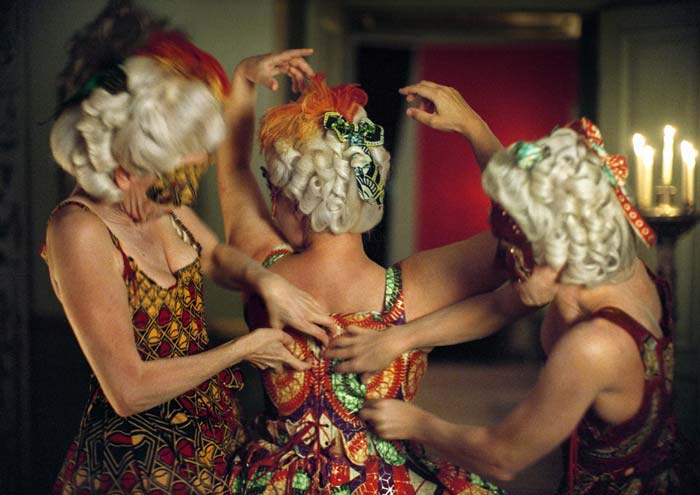
The video work fades profoundly into madness, into the concept of personality and relativity. However, what subtly links it to the exhibition’s structuring theme is also what could have linked it to any of Ėjzenštejn’s films or, rather, as we shall see, any of Tarr’s films. There are, therefore, two conceptual levels that are aimed at involving visitors to the exhibition and in both, in different ways, the spatiotemporal nature of the work plays a fundamental role.
The work’s setting is divided into two parts. First, we find ourself in front of dresses mounted on mannequins, typical of the artist’s poetics, which remind us of those worn in northern European courts centuries ago, except that the fabrics they are made of are clearly reminiscent of traditional African clothes – as well as the Chanel logo. Second, there is the work itself, a medium-length film lasting 32 minutes in which these dresses – and many others – are worn by silent actors who enact a story through an alienating dance performed strictly without music. The work’s fascinating and incredible (non) development of events is based on Giuseppe Verdi’s opera of the same name, re-elaborating the composer’s initial intentions, without having to implement the numerous changes imposed by the censorship of the period that plagued most of his theatrical compositions.
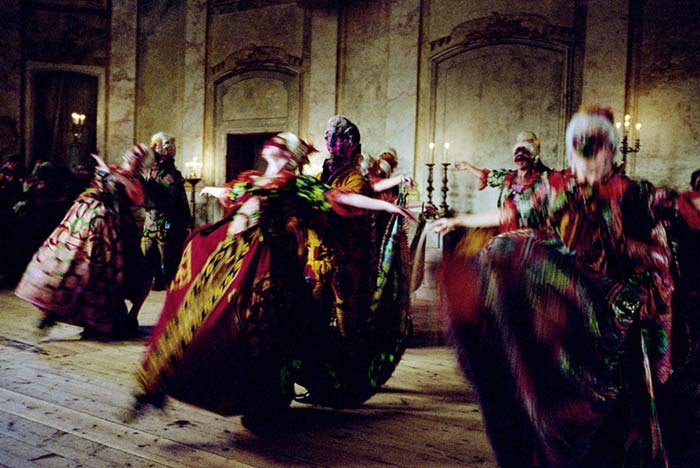
In relation to the medium, therefore, among the exhibition spaces which fascinate us, leaving us speechless and with eyes wide open, in this case we are faced with a political act, requiring our constant focus, like any political act. It is the only distinctly reflective work in the entire exhibition experience, albeit disguised as a dynamic creation, and this is also due to its technical features: it is a video, which is made up of a spatiotemporal simulation, an absurd elsewhere that is not only to be viewed, but experienced in the mystical transference of the audiovisual, in the magic of the fantastic moving image that becomes fantastic moving thought, expanding referentiality, often turned in on itself, into awareness of the world.
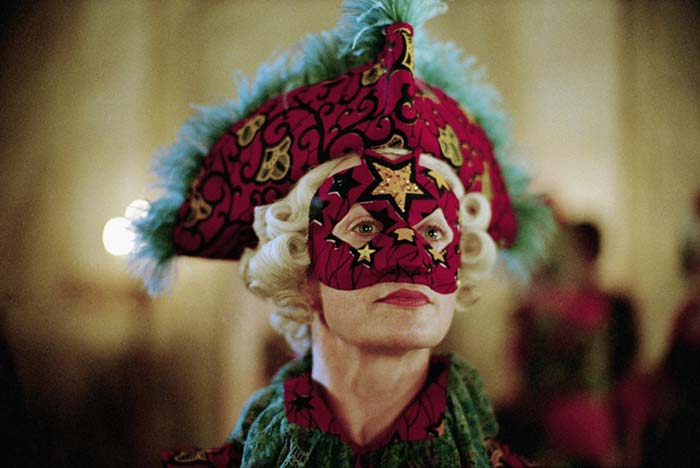
Moving closer, past the medial mirror of the screen, we find ourselves in a postmodern masked ball, inhabiting a total melting pot in the 18th century court of Gustav III of Sweden. It is the famous masked ball where the king was attacked by three masked men. In the opera we see the king dancing, then being shot and falling to the ground, pretending to faint among the general commotion, and finally getting up to start dancing again. We relive the same cycle of events three times, always identical, only to relive it three more times in reverse, with sound and video winding backwards to the initial scene, which leads to the end of the video, only to start over once more.
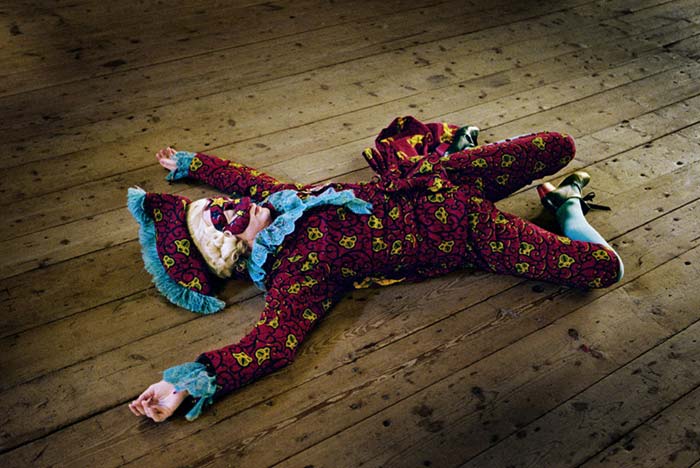
An uroboros living on montage, in a cycle of cycles that reproduces itself continuously. Exaggerated and exasperating cinematic time – what does madness consist of if not this. But there is order in this exasperation: an introduction, the same story repeated 3 times and then again repeated 3 times in reverse, and the introduction finally also repeated backwards. It is as if the very structure of the video were a dance – 4 steps forward and 4 backwards – bringing to mind Béla Tarr’s Satantango, the monumental movie that runs for almost 8 hours and is developed in 12 parts, the first 6 moving forward and the remaining 6 in flashback, then backwards, like a tango. But Un ballo in maschera (A Masked Ball) never progresses. It does not really go forwards or backwards, but dances around itself like its characters. It is viscerally digital, like a GIF – an “interchange format” that is experiential rather than “graphic”.
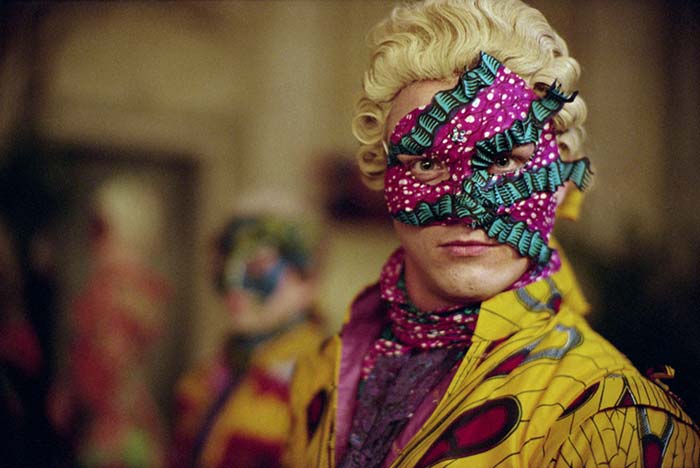
This is its most profound part, transcending the now retro audiovisual postmodernism to embrace the digital zeitgeist, which was just beginning to prevail at the dawn of the new millennium.
Its reflexive – and didactic – nature is also based on overcoming late 20th century neo-Kitsch, without ever abolishing it, but rather exploiting it to embrace a Brechtian-style hyper-estrangement. In both these cases there is a manifestation of fiction, through exaggeration and excess in the former, and through elegance of technique in the latter. Brecht led the spectator not to identify with the actors in his play, while Shonibare, in addition to this and with the audiovisual medium in mind, leads the medium of video itself not to identify with its function. The actor reveals the fact that he is acting in the same way that the masked ball reveals the fact that it is a mask, in another space-time reality which, therefore, needs no physical analogy to make sense.
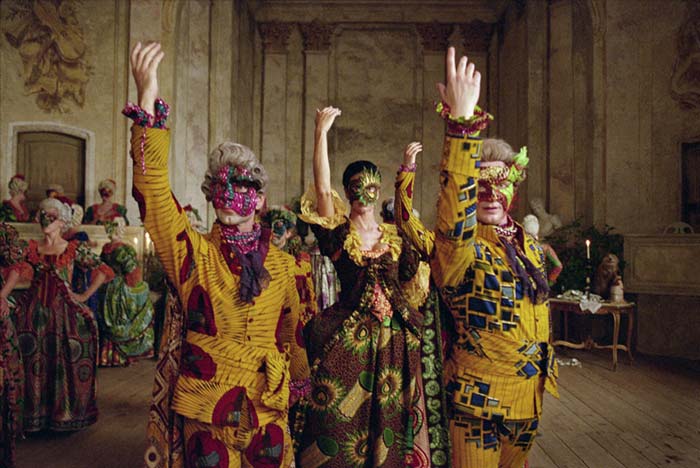 This is the essence of contemporaneity as seen through the changed gaze of the old, and now historical, camera. A work that is at once hermetic and baroque, European and African, analogue and digital, true and false, linked to Time and totally disconnected from it, in the total contradiction needed to make sense of contemporary existence. Pure madness and yet so filled with concrete, linear, structured critical sense. Shonibare’s work represents the hidden pearl in CRAZY, well worth lingering over, contemplating, taking time to enjoy it and overcome the pre-packaged existence of masks and incoherent clothes – the medium and space-time reality that turns into dance.
This is the essence of contemporaneity as seen through the changed gaze of the old, and now historical, camera. A work that is at once hermetic and baroque, European and African, analogue and digital, true and false, linked to Time and totally disconnected from it, in the total contradiction needed to make sense of contemporary existence. Pure madness and yet so filled with concrete, linear, structured critical sense. Shonibare’s work represents the hidden pearl in CRAZY, well worth lingering over, contemplating, taking time to enjoy it and overcome the pre-packaged existence of masks and incoherent clothes – the medium and space-time reality that turns into dance.
CRAZY: La follia nell’arte contemporanea (Madness in Contemporary Art), curated by Danilo Eccher, Chiostro del Bramante, Rome, 19.02 – 08.01.2023
images: (all) Yinka Shonibare, «Un ballo in maschera (a masked ball)», 2004, still from video









































